This Common Household Essential Will Make Removing Stuck Spark Plugs Easy
Spark plugs are typically the firestarters of an internal combustion gas engine. And when a spark plug goes wrong, it could potentially mean a host of problems like engine knocking, misfires, power loss, rough idling, and hard starts. Experts recommend uninstalling, inspecting, and cleaning the spark plugs at least once every 30,000 miles of driving. Furthermore, replacing the plugs every 50,000 to 60,000 miles is recommended. However, most drivers (or lawnmower owners) forget about the spark plugs until the engine refuses to start or idles roughly like a jackhammer.
Fortunately, replacing the spark plugs in a car or lawnmower is not as difficult as it sounds. Removing the plastic engine cover with a socket set is necessary for some vehicle models. Still, the procedure involves removing the ignition coils, loosening the plugs, and pulling them out of the engine. However, there are times when it's easier said than done.
Use WD-40 to loosen stuck spark plugs
The spark plugs live a hard life inside any engine. They operate between 932 to 800 degrees Fahrenheit (500 to 800 Celsius) and are prone to accumulating harmful carbon deposits. Igniting a highly combustible air-and-fuel mixture at extremely high temperatures makes a spark plug susceptible to corrosion, especially around the tips and threads. When all that gunk repeatedly cools down and bakes at high temperatures, the spark plug threads could seize or get stuck, making it almost impossible to remove without superhuman strength.
Luckily for us, we have WD-40 to the rescue. Besides its effectiveness at removing crayons from walls, degreasing your hands, or freeing a python from the engine bay of a bus (fact), WD-40's proprietary blend of lubricants, anti-corrosion agents, and water displacement formula is as good in loosening stuck spark plugs as removing baked-on bird droppings from paint.
After removing the ignition coil from the hole, moderately spray some WD-40 inside before loosening the plugs using a socket set. In some cases, allowing the product to soak for a few minutes before wrenching out the spark plugs will make the process easier. Moreover, you may need to spray more WD-40 inside the spark plug hole for older cars or neglected machinery. After removing the spark plugs, spray WD-40 on the threads and wipe off the excess using a cloth to prevent seizing after re-installation.


